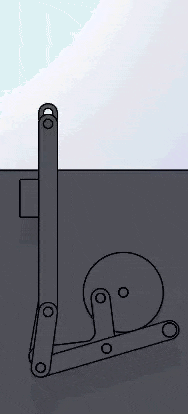Page 14 – The Lever and Elbow Linkage
The Stirling engine is rather
too tall for a boat.
The pumped beta diagram is
something like 5 times
taller than it is wide.
Boats need a low profile, low
centre of gravity engine.
The lever elbow linkage
shortens the engine by “bending” the con rods through
90o
The
displacer rod is connected
to the end of a lever. This means that the big end of the
con
rod traces out an arc. The longer the lever, which is near
horizontal, the gentler the arc. This reduces side forces and
friction.
The centre of an “elbow” is
pivoted at the mid point of the lever.
One end of the elbow
is fixed to the pin
on the crank disc.
The piston con rod is connected to
the other end of the elbow.
When the piston is pushed
by the gas, the con rod swings the elbow and, in turn,
this
pushes on the crank disc pin and turns the shaft.
This
is horrendous to describe.
Have a look at an animation
opposite.
Why bother with this linkage?
It
shortens the height of the engine whilst preserving near straight
line motion of the con rods.
There are absolutely
perfectly straight line linkages. (No side forces)
Roelf
Meijer’s
1960’s rhombic drive is rightly world famous.
But it
keeps the engine tall. (And takes some skill to make)
The
lever elbow linkage is just levers – much simpler.
